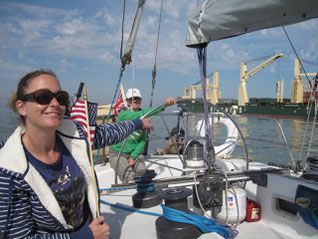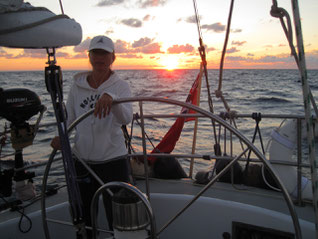We were all set. Reconditioned engine, all rigging tried and tested, the stanchions and hatches all secure and non leaking; the navigation planned and our route out of Seabrook and across the Gulf to Florida all ready.
Alongside cargo ships we followed the shipping lane down to Galveston before heading off at sun up the following day for the 700 mile trip across the Gulf. We were looking at anything between 7 and 10 days. We had been following the weather closely and all looked good for our crossing, the last thing we needed was to hit heavy weather whist negotiating the thousands of oil rigs that dot the seascape. Some are large platforms with lights and sound signals, others are smaller and some are unlit. What with the fishing boats working the waters, the first three days were hazardous and tiring as we got into the routine of watches and life at sea.





300 miles underway we felt the wind pick up around 7 o’clock in the evening. The waves built in height and the wind strengthened and it took all our strength to hold the boat steady as we flew through the water. The waves and wind were coming from our portside stern so we were not getting wet and the going was relatively comfortable as we were going in the same direction. However the helm was becoming harder to hold so it was decided to shorten the watches which obviously meant less time for sleeping. Looking back at the log the storm lasted for roughly 14 hours but it felt so much longer than this, no doubt due to exhaustion. Throughout the next day the wind blew at a steady 30 knots, and I just wished for it to lessen. The next night the wind continued to blow all night but the waves had died down and on coming onto my shift I was told by a very excited Ben that it was like driving a Formula 1 car, he had been having a great time.
As day break approached the wind finally started to die down and by 8am the wind had completely gone. We decided to put the engine on for a while to keep up the progress and charge the batteries. NOTHING. DEAD. We changed to the starter battery, we turned off everything on the boat but to no avail. After half an hour of trying we decided to tie up the helm and all go for a sleep. We had passed all oil rigs and thought that a quick nap would be of no danger.

After a short rest Ben tried to get the engine going, and finally after using starter fluid and the spare batteries he somehow managed to get the thing fired up. When the wind picked up we would obviously sail and turn the engine off, but each time trying to get it started again was a mission and we were seriously concerned we could end up out in the Gulf for weeks, just bobbing along.


The storm had taken us 300 miles offshore, right into the middle of the Gulf so our initial plan of making a route to somewhere in Alabama/Louisiana to get an updated weather report was of no use. The closest shore line was Florida. We decided to head for St Petersburg as we really needed to get the engine looked at and to top things off the autopilot’s hydraulic ram had disconnected from the rudder post and so needed to be fixed.
The last 3 days of the trip were all done hand steering, a tiresome job especially when under motor. We had some steady winds and some calm seas for the remainder of the journey and we arrived at the entrance of the shipping channel in the early hours of the morning, deciding to wait until sun up to negotiate the route.

 Saint Lucia's Premier Sailing School
&
Race Yacht Experience
Saint Lucia's Premier Sailing School
&
Race Yacht Experience






Write a comment